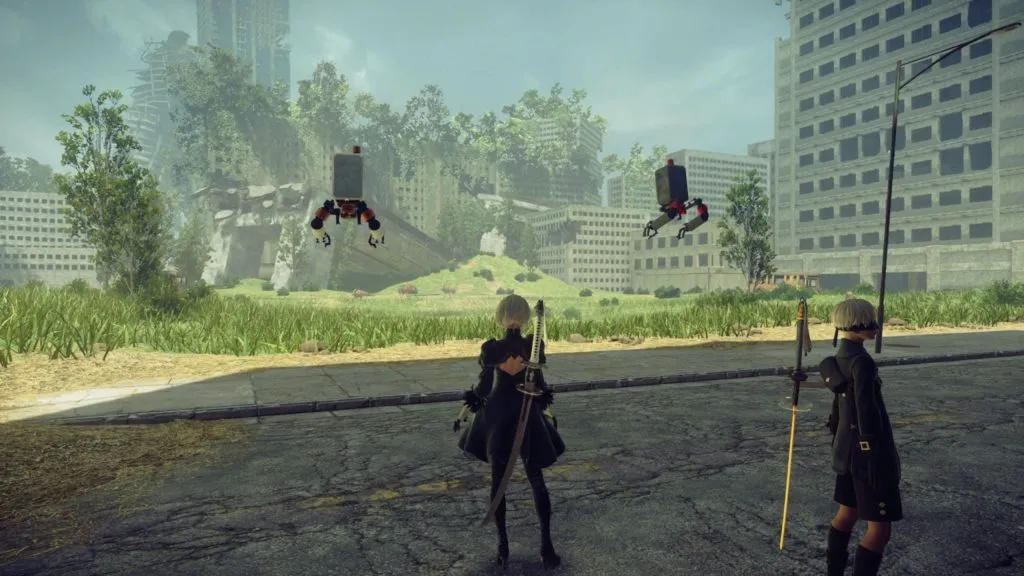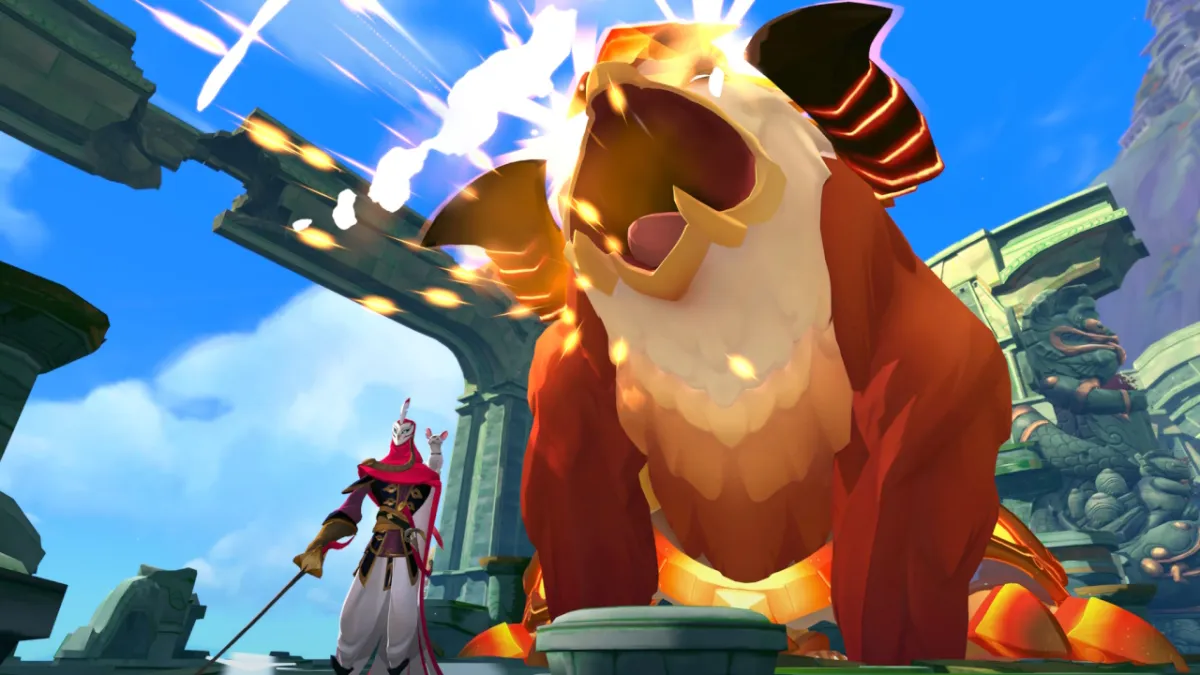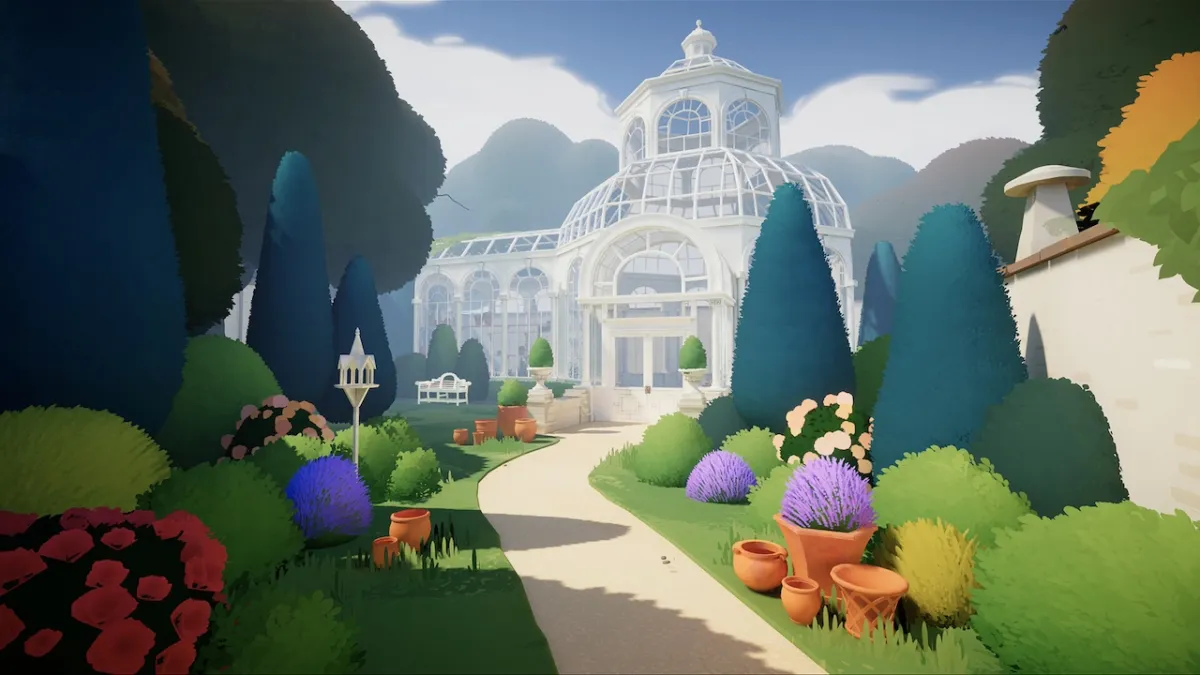Saying that I’ve had high hopes for NieR: Automata is a bit of an understatement. NieR itself was a tremendously weird game, and the prospect of seeing what came after was a very, very exciting one. In fact, I went through and finished NieR: Automata on the PlayStation 4 a week or so ago. I know, I know. I’m sorry.
In my defence, it is a good game. It’s the sort of good game that some people are going to hate, and some will wonder why on Earth anyone thinks it’s good; it’s going to be divisive, and I’ll be discussing that in the full review. If I had one issue with the PlayStation 4 version, though, it’s that the controls are a teeny bit rough. Controlling the camera and trying to aim your gunfire and trying to play a Devil May Cry-esque action beat-’em-up is a tough ask for pretty much any controller, but maybe – just maybe – it would improve on PC.
So, one 45GB download later, let’s take a look at how NieR: Automata is handled by the PC. Once again, we’re looking at this through the technical lens of my i7-3820 with 16GB RAM and a GeForce GTX 970, which should give you an idea of performance.
PC-specific options are a mixed bag, with some disappointments but a few genuinely pleasant surprises. On the disappointing side of things are the visual options, which you can see below.
Resolutions go from 640×480 to 5120×2880 with a wide range (no pun intended) of aspect ratios supported, which is decent. Windowed and Fullscreen are both supported, although Borderless Windowed is apparently missing in action. Happily, there’s an option to select which monitor you want the game displayed on.
As for raw visuals… eh. There’s Anti-Aliasing up to 8x, Texture Filtering up to 16x, Blur, Ambient Occlusion, High/Low Effects, and High/Medium/Low Shadows. It’s not tremendously scaleable, and that’s rather disappointing.
Things fare better outside of the visuals, though. Most of the stuff is what you’d expect (volume settings, camera rotation speeds, etc.) but there are a couple of nods to the PC audience. There are Inactive Play and Inactive Sound settings, for instance, which determines whether the game tracks your inputs/plays audio even when it’s not the active window.
Keyboard and gamepad controls are both fully customisable. I had a mild moment of terror on seeing that the keyboard controls include binds to the arrow keys for moving the camera, but don’t worry: the mouse is fully supported, both in the menus and in the game. There also appear to be a couple of new binds that I don’t remember at all from the PS4 version, like an MMO-style autorun button that keeps you jogging in the direction of your choice after you release the directional key, as well as a “Shortcuts” key that pauses the game and brings up a quick-select menu for your Pods, restorative items, and weapons.
(There is similar in the PS4 version, but it doesn’t pause the game and it pops up in the lower-left rather than filling the screen. This alternate shortcut menu also exists in the PC version and is bound to the mousewheel directions, which mimics the D-pad inputs it used on the console. It’s better than it sounds, honestly.)
The default binds are pretty sensible. WASD control movement, with left and right mouse buttons for Light and Heavy attacks, and Shift firing your ranged weapon at the centre of the camera. Q is used for lock-on, E is use, and a tap of 1 triggers your Pod ability (think a superweapon with a long-ish cooldown). Even Self-Destruct – a button you don’t really want to accidentally press, even though you have to hold it down for two seconds to make it go off – is placed sensibly, having been bound to B, which should be far enough away from your hands that even a casual fat-fingered mis-press won’t trigger it.

NieR: Automata does a lot of fun stuff with its graphics. The orbiting Bunker that acts as your home base, for instance, is entirely monochrome.
One other thing which has drastically changed between PC and console is that the console version had a dedicated button for dodging, while keyboard controls switch this to a double-tap of a direction. I’m not sure whether I prefer this or not, honestly: double-tapping a key is somewhat less precise than holding a direction and pressing an extra button, but that might also be muscle memory causing me problems. Alas, I can’t see a way to change this. The keyboard seems to force a double-tap rather than having an optional Evade key. I’d kinda like to have Evade bound to Shift and maybe use F to fire or something, but…
The one big downside to the control options is that the mouse buttons don’t seem to be rebindable. There are always ways around this, but I’d be happier not to have to use external programs to do it.
This is kinda what I mean by “mixed bag.” On the one hand, the visual options are disappointing, and the optimisation really isn’t that great (which we’ll get to shortly); equally, there a few big problems with mouse and keyboard controls in this game. On the other hand, attention has clearly been paid to the unique challenges of playing NieR: Automata on a mouse and keyboard; I can’t think of many developers who’d actually change the way an Evade function works for the PC version, even if I don’t necessarily agree with their decision. It’s a really unusual mix.
Before we talk about performance, there are two things worth noting. First, Square Enix have stated that there are some issues with very specific Radeon set-ups: specifically, a Windows 10 system with a Radeon RX400 series card running the Crimson ReLive Edition 17.2.1 drivers can cause the game to blank out. Apparently, this can be solved by updating the graphics card drivers, so… okay. Secondly, despite being present, 4K support is not officially supported and may cause weird issues. I have a sneaking suspicion that this is actually true of everything above 1080p, because this would explain some of the optimisation issues.
Okay, performance! NieR: Automata is locked to 60FPS, with cutscenes capped at 30FPS. At my native resolution of 2560×1440, it doesn’t really manage that at all.
With the settings preset to High (maximum, essentially), NieR: Automata struggles to maintain a constant 20FPS at 2560×1440. Dropped to Low, things improved to “mostly playable”, with an average of 40-45 FPS and a few drops further – but that’s still pretty far from what I’d like.
Things are significantly better on 1920×1080, with Low easily managing 60FPS even in busy distance scenes, and High making a solid attempt at a constant 40FPS.

I started off thinking that the robots didn’t (and wouldn’t) have much character as enemies. By the end of the game, though, I was most definitely wrong.
Anti-Aliasing is the real problem, it seems: putting every setting to Maximum but leaving Anti-Aliasing off still keeps the game at around 60FPS, with occasional drops to 55FPS. Bumping Anti-Aliasing up to the bare minimum of 2X immediately drops this by a full 10FPS. I’m curious as to whether there’s a way around this by futzing with graphics card settings and having the card manually handle this stuff, but I’m fairly inexperienced with that.
There’s also some weirdness with the resolution itself, and I have no idea what it is or how to describe it. While the game is fine, my Windows cursor never appears to be actually displayed at the correct resolution and comes off as squashed; the menus feel slightly “wrong”; and it seems to adjust the resolution every time I start the game or change a graphical setting. By this, I mean it blanks the screen temporarily and moves things around on my second window, so it seems to… lower the desktop resolution, or something? I really don’t know. In any case, it doesn’t seem to impact the game itself, but it’s an oddity.
I’ve seen a few reports online that the game is rendering in 900p even in fullscreen, so this issue might be related, but as far as I can tell it’s rendering at the appropriate resolution. Hmm.
In any case, it looks pretty damn lovely regardless of the settings you use. Here’s a High/Low comparison gallery from the start of the open world stuff, at 2560×1440:
It’s probably saying something that I’m not one hundred percent certain I’ve labeled these correctly. The visual difference between Low and High really isn’t all that striking; textures are sharper, some of the effects are nicer, and the anti-aliasing is noticeable, but that’s about it.
You can also pick holes in some of the texture quality, but I can pretty much guarantee you won’t care so much when in the game itself. It does a lot with its animations, art style, and filtering, and creates a very memorable and hauntingly beautiful experience. We’ll get to that in the game review proper, though.
So, let’s have a look at the controls. This is a bit tricky because NieR: Automata doesn’t really fit into any one genre. It’s a 3D/2D linear/open-world action-adventure/scrolling-shooter/twin-stick shooter/platformer/beat-’em-up/RPG. Still, I suppose there are a few areas I should really focus on.

Oh, and it mashes those genres up. Even the fighting bits (which is the biggest chunk of the game) have bullet hell aspects.
Firstly, the 3D fighting stuff. This is mostly okay, although it does suffer the same problem as the console version in that, in trying to do a little too much, the controls don’t quite work. It’s a very cinematic game, which means that it routinely takes the camera away from you, and this can really screw with your aiming. The lock-on function helps with this quite a lot… but that’s disabled on the two higher difficulties, so good luck with that.
It also seems to change camera sensitivity on the fly, and the camera has a degree of inertia that makes it a bit of a pig to precisely aim. The latter is a problem that I resent for even existing, while the former is mostly down to its shifts from a free camera to a more limited one: if the game wants you looking in a certain direction, your sensitivity seems to be dropped. It’s very, very hard to describe, so let’s just say that the sensitivity is inconsistent. It seems pretty okay in the open world segments, though, as those generally let you roam at will and don’t try to interrupt you.
Second, the scrolling-shooter bits. These are fine. It would take something spectacular to screw these up.
Third, the twin-stick shooter bits. These are not fine, and they are arguably the biggest problem with the PC version’s controls. As you’d expect, you use WASD to move and the mouse to aim… but there’s no crosshair. Instead, NieR: Automata treats the mouse as an analogue stick, and you have to nudge it in the direction you want to fire. What makes this infinitely worse, though, is that you have to keep moving it or the aim will reset to the direction your character is moving. Holding an analogue stick in one direction is one thing. Holding a mouse in one direction is physically impossible because that’s not how mice work. Continually moving the mouse to the upper-left of the mousepad just to try to keep a relatively consistent aim to the top-left is a nightmare, and when you have to pick up the mouse to reset its position on the pad… welp.
This is egregious if only because this could so easily be solved by adding a crosshair into these sections so that your aim is kept in one spot irrespective of character movement, which would actually make these segments entirely mouse/keyboard compatible. This is irritating early on, but these segments can get rough later in the game.
(Update: Two things of note, as asked by people in our Discord server. Firstly, you can hotswap between pad and keyboard/mouse controls at any point, and visual prompts change accordingly. As such, it’s possible to play different segments with different control schemes. Secondly, it may be possible to use WASD and the arrow keys for controlling and aiming the twin-stick bits, since the arrow keys pretty much double as the right analogue stick in the main game. I’ll test this and will update.)
Depressingly, NieR: Automata is a port rather than a full-fledged PC version, and right now it’s a bit tricky to recommend. Performance is lower than expected (and problematic if you’re on the lower end of the specs), scaleables are limited, and the controls are… interesting. Twin-stick bits aside, it might be a case of just getting used to them, but I’m going to need more time to figure that one out.
If you have a solid system, a controller, and are lucky enough that you don’t hit any of the issues I’ve seen reported online – ranging from crashes, the 900p rendering, and performance issues on computers that shouldn’t have performance issues – then there’s little reason to opt for the console version over this. For now, though, I’d wait for a patch at the very least, because the truth is this isn’t anywhere near where it should be.
Our full review of NieR: Automata will be coming soon, and I’ll be playing through the game with mouse and keyboard. Wish me luck.





















